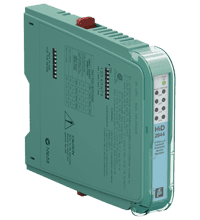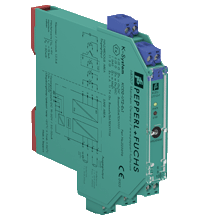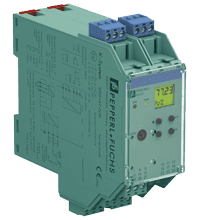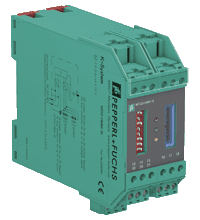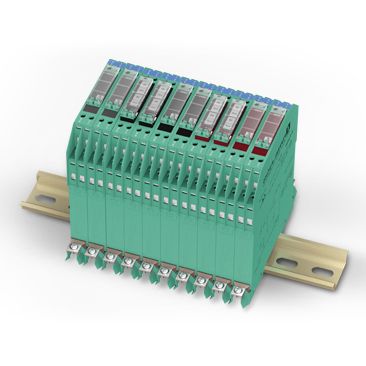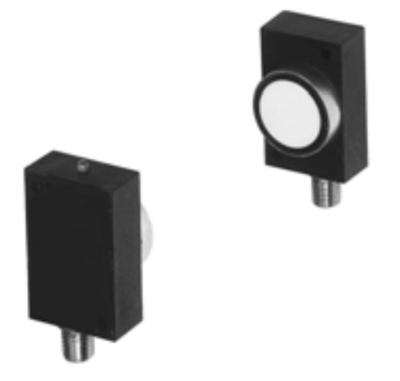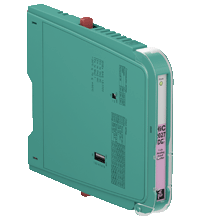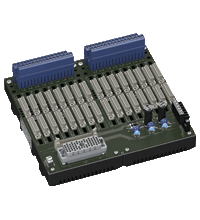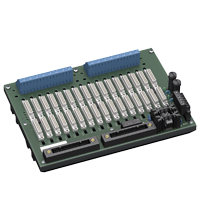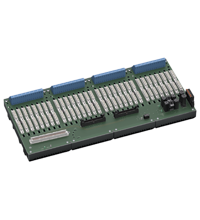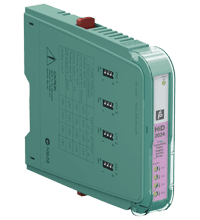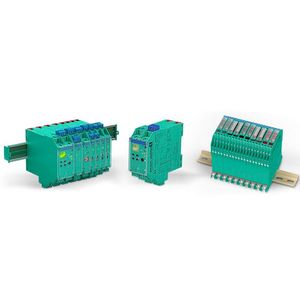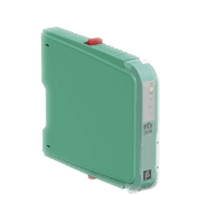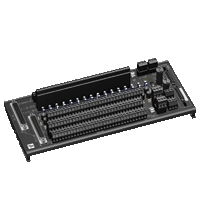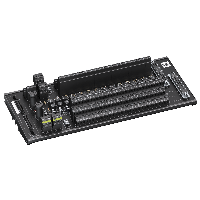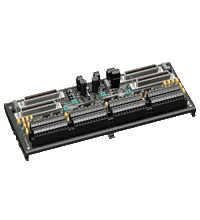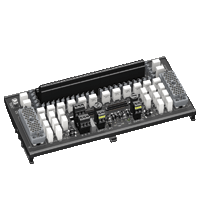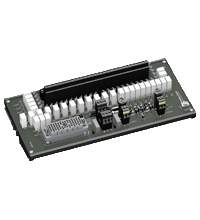Pepperl+Fuchs Intrinsic Safety Barriers
This item is out of production!
- 4-channel isolated barrier
- 24 V DC supply (bus powered)
- Dry contact or NAMUR inputs
- 4 passive transistor outputs
- Line fault detection (LFD)
- Up to SIL 2 acc. to IEC 61508
- 1-channel isolated barrier
- 24 V DC supply (Power Rail)
- Thermocouple, RTD, potentiometer or voltage input
- Current output 0/4 mA ... 20 mA
- Sink or source mode
- Configurable by PACTware
- Line fault (LFD) and sensor burnout detection
- Up to SIL 2 acc. to IEC 61508/IEC 61511
- 1-channel isolated barrier
- 24 V DC supply (Power Rail)
- HART field device input with transmitter power supply
- Usable as signal splitter (1 input and several outputs)
- 3 analog outputs 4 mA ... 20 mA
- Sink and source mode output
- Configurable by keypad
- 16-channel
- 24 V DC supply (Power Rail)
- HART field device input (revision 5 to 7)
- Up to 15 KFD0-HMS-16 slave units can be connected
- Up to SIL3 acc. to IEC 61508
- Isolated USB interface cable
- Used with K-, E- and H-System devices
- Used with PACTware
Pepperl+Fuchs UBE150-F64-SE2-V3 ultrasonic fence
- Wide viewing angle: 180°
- Detection distance: up to 1 meter
- Insensitive to dirt and dust: can be used in a variety of environments
- System board for Honeywell Safety Manager
- For 16-channel AI card SAI-1620m
- For 16 modules
- Recommended module: HiC2025(A) (AI)
- 24 V DC supply
- Hazardous area: pluggable screw terminals, blue
- Non-hazardous area: SiC plug, 20-pin
- 1-channel isolated barrier
- 24 V DC supply (bus powered)
- Input for 2-wire SMART transmitters and current sources
- Signal splitter (1 input and 2 outputs)
- Dual output 0/4 mA ... 20 mA or 0/1 V ... 5 V
- Up to SIL 2 acc. to IEC 61508
- 1-channel isolated barrier
- 24 V DC supply (bus powered)
- Input for 2-wire SMART transmitters and current sources
- Signal splitter (1 input and 2 outputs)
- Dual output 0/4 mA ... 20 mA or 0/1 V ... 5 V
- Up to SIL 3 acc. to IEC 61508
- 1-channel isolated barrier
- 24 V DC supply (bus powered)
- Dry contact or NAMUR input
- Usable as signal splitter (1 input and 2 outputs)
- 2 passive transistor outputs
- 1-channel isolated barrier
- 24 V DC supply (bus or loop powered)
- Output 45 mA at 12 V DC
- Line fault transparency (LFT)
- Test pulse immunity
- Up to SIL 3 acc. to IEC/EN 61508
- System board for HIMA, HIMax
- For 16-channel card X-AO 1601 (AO, single mode)
- 16-channel card X-AO 1601 (AO, redundant mode on request)
- For 16 modules
- Recommended module: HiC2031 (AO)
- 24 V DC supply
- Hazardous area: spring terminals, blue
- Safe area: HIMA system connector, 96-pin
- System board for Triconex (approval TAN48)
- For 32-channel AI cards 3700A, and 3721
- For 16 modules
- Recommended module: HiC2025 (AI)
- 24 V DC supply
- Hazardous area: pluggable screw terminals, blue
- Safe area: ELCO socket, 56-pin
- System board for Yokogawa CENTUM VP
- For 16-channel AI cards AAI143, AAB141-H
- For 16 modules
- Recommended modules: HiC2025(A) (AI), HiC2081 (TI)
- 24 V DC supply
- Hazardous area: spring terminals, blue
- Non-hazardous area: Yokogawa system connector, 40-pin
- System board for Yokogawa CENTUM VP
- For 16-channel AI/AO card AAB841
- For 16 modules
- Recommended modules: HiC2025 (AI), HiC2031 (AO)
- 24 V DC supply
- Hazardous area: spring terminals, blue
- Safe area: Yokogawa system connector, 40-pin
- System board for HIMA, HIMax
- For 32-channel cards X-AI 32 01 or X-AI 32 02 (AI)
- For 32 modules
- Recommended modules: HiC2025 (AI), HiC2081 (TI)
- 24 V DC supply
- Hazardous area: spring terminals, blue
- Safe area: HIMA system connector, 96-pin
This item is out of production!
- 4-channel isolated barrier
- 24 V DC supply (bus powered)
- Analog in or analog out signals
- Sink and source mode outputs
- SMART pass-through
- Up to SIL 2 acc. to IEC 61508
This item is out of production!
2-channel isolated barrier
This item is out of production!
This Item is out of Production!
2-channel, 24 V DC supply, Current output up to 750 Omega- load
- 32-channel
- 24 V DC supply
- Interface for serial or parallel wiring options
- Dual RS 485 connections
- Slot for HART Multiplexer
- Ideal for retrofitting existing installations
- Interface for serial or parallel wiring options
- 37-pin Sub-D connectors
- Redundant power supply connections
- HART filter options
- Fuse options
- 32-channel
- 24 V DC supply
- For analog output cards
- HART output filters
- Interface for serial or parallel wiring options
- 37-pin Sub-D connectors
- Slot for HART Multiplexer
- TDC 3000 replacement FTA
- Short-circuit protected
- Redundant PCS wirings
- Redundant power supply connections
- Field terminal blocks that are Honeywell FTA compatible
- Honeywell ""B"" size footprint
- Triconex 3700A and 3721 replacement FTA
- 2- or 3-wire or self powered transmitters
- Outputs: 2 x 16 channels, 0 V ... 10 V differential, DC coupled (makes 32 channels)
- Short-circuit protected
- Plug-n-play wiring capabilities
- Triconex 3700A and 3721 replacement FTA
- 2- or 3-wire or self powered transmitters
- Outputs: 2 x 16 channels, 0 V ... 10 V differential, DC coupled (makes 32 channels)
- Short-circuit protected
- Plug-n-play wiring capabilities
- Optimized for use in floating power configurations
- Triconex 3704E and 3720 replacement FTA
- 2- or 3-wire or self powered transmitters
- Outputs: 1 x 32 channels, 0 V ... 5 V differential, DC coupled
- Short-circuit protected
- Plug-n-play wiring capabilities
- Triconex 3805E replacement FTA
- 32 channels of I/O
- Outputs: 4 x 8 channels, 4 mA ... 20 mA current loop, DC coupled
- Short-circuit protected
- HART analog output filters
- 2-channel isolated barrier
- 24 V DC supply (Power Rail)
- Analog input (AI), Analog output (AO)
- Operates as transmitter power supply or current driver
- Housing width 12.5 mm
- Up to SIL 2 (SC 3) acc. to IEC/EN 61508
- 1-channel isolated barrier
- 24 V DC supply (Power Rail)
- Dry contact or NAMUR inputs
- Relay contact output
- Line fault detection (LFD)
- Housing width 12.5 mm
- Up to SIL 2 (SC 3) acc. to IEC/EN 61508
APCS at the enterprises of the petrochemical, chemical, and gas industries operate with information collected mainly from objects located in potentially explosive environments. Therefore, the selection of highly reliable and economical technical means of collecting information operating in these environments is a top priority when designing an automatic control system. The use of communication channels equipped with intrinsic safety circuits in hazardous areas is one of the necessary ways to ensure safety.
Intrinsic safety barriers are designed for use in industries related to the receipt, processing, use, and storage of explosive and flammable substances. Let's take a closer look at Pepperl+Fuchs intrinsic safety barriers.
What is an Intrinsic Safety Barrier
An intrinsic safety barrier is an electronic protective device (often of a modular design) installed in series in a circuit between the intrinsically safe and intrinsically dangerous zones of a plant, in other words, between the explosive and non-explosive zones.
Isolated barriers are required in production where sensors are placed in areas with explosive mixtures and vapors. intrinsic safety barriers are specifically designed to prevent interruption of APCS operations in hazardous area facilities.
Obviously, this device must, first of all, meet the requirements for intrinsic safety, therefore, such equipment is traditionally filled with a compound, and such devices are called intrinsically safe units. Obviously, repair of the intrinsic safety barriers is not provided - such is the price for safety.
A spark protection barrier is an excellent tool that allows you to inexpensively, lightly, and at the same time reliably protect equipment from sparks of an electrical nature.
In general, barrier safety has a number of advantages: such devices are versatile, inexpensive, easy to install, have small dimensions, and have a simple modular design that is convenient for dense mounting.
How Intrinsic Safety Barriers Work
To ensure safety, intrinsic protection barriers are used as separating elements between intrinsically hazardous and intrinsically safe circuits - blocks in the form of separate or built-in electrical equipment. intrinsic safety barriers limit the flow of power through a circuit, thereby protecting hazardous areas from power surges.
By limiting the power supply to a safe level, intrinsically safe circuits prevent sparks from forming in potentially explosive atmospheres. This greatly simplifies the maintenance and repair of “Ex i” circuits.
The intrinsic safety barrier transmits the current signal from the hazardous area to the non-hazardous area. The built-in switching source powers the input and output circuits of the barrier. And the presence of galvanic isolation of circuits eliminates the need to ground the device.
Pepperl+Fuchs Intrinsic Safety Barriers
Pepperl+Fuchs intrinsic safety barriers are the core product of the company's portfolio. These intrinsic safety modules combine the energy-limiting functions of a Zener barrier with galvanic isolation. Pepperl+Fuchs offers systems for a variety of applications and installations.
Isolated Barriers (K-System)
The most common of the DIN rail-mounted intrinsic safety barriers. They are easily connected using a power rail mounted on a DIN rail. The Power Rail reduces the use of cables by including modules mounted on a DIN rail.
Isolated Barriers (H-System)
System H intrinsic safety barriers are mounted on the termination boards. This innovative product is ideal for smaller DCS applications or system integration.
Zener Barriers
System Z Zener barriers are a cost-effective explosion protection solution for a wide range of process automation applications. They limit the amount of energy to a safe level where it is impossible to ignite an explosive atmosphere. Mounted directly on a 35mm DIN rail.
Pepperl+Fuchs intrinsic safety barriers advantages.
- Fast DIN rail mounting.
- Direct grounding with DIN rail accessories.
- Separation of the production line by removing the fuse.
High-density Z system Zener barriers are available up to 2 channels/12.5mm wide. Replaceable fuse versions offer a convenient means of disconnecting or breaking the circuit of the equipment without interfering with the wiring, simplifying commissioning and maintenance.
Applications for Pepperl+Fuchs Intrinsic Safety Barriers
Let's look at the main purposes of using intrinsic safety barriers.
- Ensuring the intrinsic safety of the input/output circuits of sensors and actuators that are located in explosive areas (preventing the ingress of electric current, which can cause a spark).
- Protection of process control systems of enterprises and ensuring their uninterrupted operation; protection of equipment located in a safe area.
- Increasing the system level of reliability in the enterprise.
Intrinsic safety barriers are used everywhere where special system protection is required.
Main areas:
- Management and control systems for technological processes in production.
- Measuring systems.
- Alarm and emergency protection systems.
- Thermal power complex.
- Chemical and petrochemical industry.
- Oil and gas complex.
- food industry.
- Metallurgy.
It is possible that equipment protection may never be needed, but by using explosion-proof equipment, financial losses associated with its failure, and sometimes catastrophic consequences, can be prevented. If you want to know more, you can study the intrinsic safety barrier circuit or seek advice from our managers.
